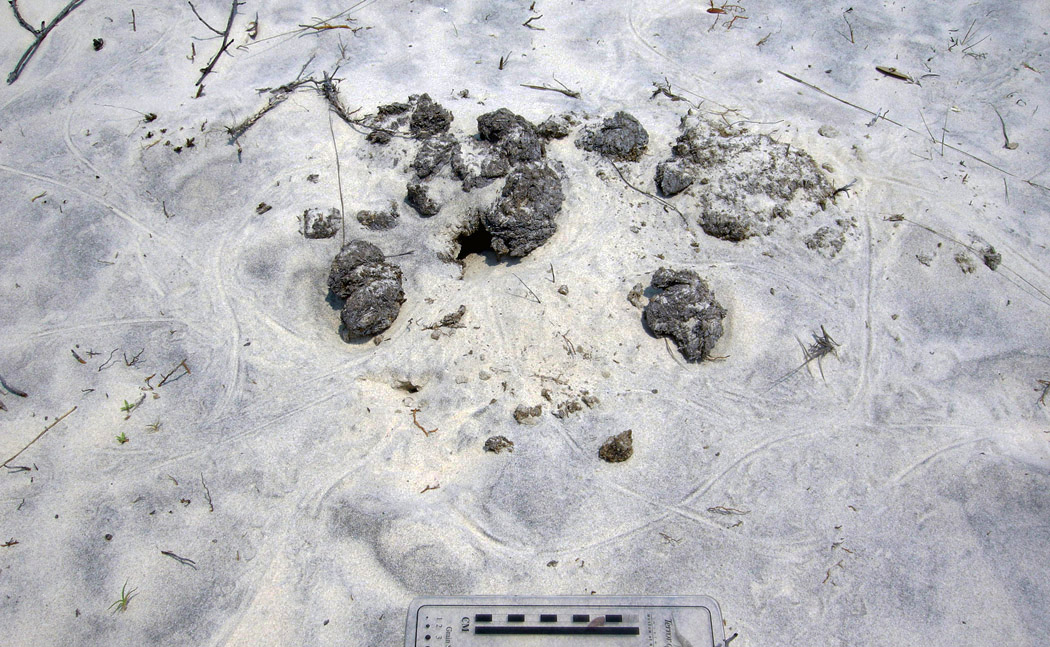Continuing the theme of “On the __th Day of Ichnology, My Island Gave to Me,” today’s photo and explanation constitute a veritable cornucopia of ichnological goodness. It not only shows traces from two Georgia-coast species that differ greatly in size, but also three types of traces. The tracemakers are small lizards – probably ground skinks (Scincella
lateralis) – and feral horses (Equus caballus), and the traces are trackways, feces, and a burrow, all of which are connected to one another.
 Lizard trackways looping around feral-horse dung piles in dunes near Lake Whitney on Cumberland Island, Georgia. But wait, what’s that little hole underneath one of the piles? Why, would that be a lizard burrow? Why, yes indeed, which means that this lizard has horse excrement as the roof to its home. Please feel free to make your own joke about shingles. (Photograph by Anthony Martin, scale in centimeters.)
Lizard trackways looping around feral-horse dung piles in dunes near Lake Whitney on Cumberland Island, Georgia. But wait, what’s that little hole underneath one of the piles? Why, would that be a lizard burrow? Why, yes indeed, which means that this lizard has horse excrement as the roof to its home. Please feel free to make your own joke about shingles. (Photograph by Anthony Martin, scale in centimeters.)
As far as I know, all of the skinks and other lizards on the Georgia barrier islands are native to the islands and identical to those on the mainland. In contrast, the horses are not native to the Georgia coast, and would not be considered “native” even if they were descended from Spanish horses, which they’re not. Anyway, the horses, which only live a free-manging, er, I mean, free-ranging life on Cumberland Island, leave sufficient quantities of feces that the dung beetles cannot keep up with them. As a result, old and dried horse dung is easily spotted on sand dunes, telling of a former horse presence that can sometimes last for weeks before it breaks down.
Even though people like me might get tired of this crap, the lizards take it all in stride, as in, they just stride around it like any other obstacles they might have in their ecosystems. Think of the horse-dung piles as little hills, and the lizards avoiding them by staying in the valleys. In this instance, their trackways and the old dung piles were in a sand dune near Lake Whitney, the largest freshwater lake of any of the Georgia barrier islands.
The big bonus in this photo, though, is the skink-sized burrow (top center) underneath one of the dung balls, with tracks leading into and out of it. So at least one lizard thought this was this was a splendid place to site its home, enjoying the luxury of a solid, prefab roof in a place with lots of soft, shifting sand.
How to apply these observations to the fossil record? Well, surely animals that were smaller than the dung piles of large land vertebrates in the geologic past must have likewise moved around these as objects that got in their way. Hence trackways reflecting such behaviors might show looping patterns, instead of straight or simply turning to the right or left.
But did any of these small animals also take advantage of these droppings as shelters, in which they decided that they should not go to waste? If so, a coprolite with a small burrow underneath it would be a most fortuitous two-for-one trace fossil, one that could only be made better if the burrow-maker’s tracks were also preserved going into and out of the burrow. Imagine finding something like this in the fossil record: tracks, feces, and a burrow, all together and from two different species and demonstrating that the feces influenced the other two traces. Be still, my ichnologically inspired heart!
Further Reading
Ground skink (Scincella lateralis). Savannah River Ecology Laboratory, University of Georgia.
Feral Animals of Cumberland Island. Wild Cumberland (by Hal Wright and Rhett Lawrence).
Links to Previous Posts in This Theme
On the 12th Day of Ichnology, My Island Gave to Me: 12 Snails Grazing
On the 11th Day of Ichnology, My Island Gave to Me: 11 Plovers Probing
On the 10th Day of Ichnology, My Island Gave to Me: 10 Beetles Boring
On the 9th Day of Ichnology, My Island Gave to Me: 9 Molluscans Hiding
On the 8th Day of Ichnology, My Island Gave to Me: 7 Lizards Looping
